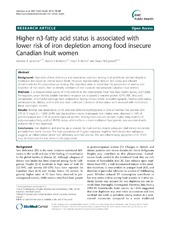| dc.description.abstract | Background: High rates of iron deficiency and anemia are common among Inuit and Arctic women despite a traditional diet based on animal source foods. However, representative data on iron status and relevant determinants for this population are lacking. The objectives were to determine the prevalence of anemia and depletion of iron stores, then to identify correlates of iron status in non-pregnant Canadian Inuit women. Methods: In a cross-sectional survey of 1550 women in the International Polar Year Inuit Health Survey, 2007-2008, hemoglobin, serum ferritin, soluble transferrin receptor (on a subset), C-reactive protein (CRP), RBC fatty acid composition, and H pylori serology were analyzed on fasting venous blood. Sociodemographic, food security status, anthropometric, dietary, and health data were collected. Correlates of iron status were assessed with multivariate linear and logistic models. Results: Anemia was observed in 21.7% and iron deficient erythropoiesis in 3.3% of women. For women with CRP ≤ 10 mg/L (n = 1260) 29.4% had depleted iron stores. Inadequate iron intakes were observed in 16% of premenopausal and <1% of postmenopausal women. Among food insecure women, higher long-chain (n-3) polyunsaturated fatty acid (LC-PUFA) status, which reflects a more traditional food pattern, was associated with reduced risk of iron depletion. Conclusions: Iron depletion and anemia are a concern for Inuit women despite adequate total dietary iron intake primarily from heme sources. The high prevalence of H. pylori exposure, together with dietary iron adequacy, suggests an inflammation-driven iron deficiency and mild anemia. The anti-inflammatory properties of LC-PUFA may be important for iron status in this population. | en_US |

